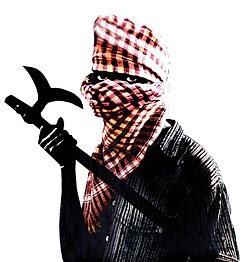 |
The rout of both the BJP and the CPI-M in April's election represented setbacks for the Hindu-right and the Maoist-left in Nepal. In India itself, post-election politics has been dominated by a surge in the activity of India's restless Maoists, prompting the federal government on Monday to ban the party.
The Naxalites are now active in 165 of India's 604 districts, mainly in the mineral-rich forests of eastern India populated by indigenous people. Fifty-one of these districts in Bihar, Jharkhand, Orissa, Chattisgarh and Andhra Pradesh are said to be 'highly affected'. And in the past few months, the Maoists have returned to West Bengal where they started out as a peasant movement in 1967 and were later ruthlessly crushed by the Indira Gandhi government.
After more or less pretending it didn't exist for decades, India's national media has suddenly started giving prominent space to the insurgency. The occupation of the Lalgarh area of West Bengal and the effort by security forces to retake it displaced even cricket as the main news in India's tabloid tv news which carried sensational bold banners that said 'Red Terror' in big crimson letters. The Indian media has also stopped calling the rebels 'Naxalites'.
How India's state governments now deal with their Maoist insurgencies will have a bearing on Nepal because the Indian revolutionaries have often said they want to "liberate everything from Tirupathi to Pashupati". Similarly, the future political trajectory of the Maoists in Nepal will be keenly watched by both India's ultra-left as well as the central government.
Indian Prime Minister Manmohan Singh has characterised the Maoist insurgency "as India's greatest security threat". The Indian security establishment was also closely following the Sri Lankan Army's defeat of the Tamil Tigers as a case study of a successful counter-insurgency operation.
Seen in this light, it is not a surprise that India's military-intelligence establishment took a dim view of the attempt by Nepal's Maoists to sack Gen Katawal and infiltrate the Nepal Army. "That was the last straw, we just couldn't allow that," said one Indian source.
Indian Foreign Secretary Shiv Shankar Menon, on returning here after his Nepal visit, denied there were any links between the Nepal Maoists and their Indian comrades. However, there seems to be close solidarity between the Naxalites and the hardliner bloc among Nepal's Maoists.
After April 2006, Indian revolutionaries sharply criticised Pushpa Kamal Dahal for having ended the armed struggle, and in recent interviews they have egged on hardline ideologues in Nepal.
There is also new evidence that the Indian Maoists not just trained their Nepali comrades but even planned and took part in some of the attacks on police stations and army bases in Nepal during the war. On Tuesday, Bihar Police claimed it captured two truck loads of dynamite and detonators in a truck carrying boulders from Nepal.
India's moderate communists were the architects of the November 2005 peace process when they were in a UPA coalition with the Congress. They were hoping to set an example of "taming ultra-left adventurism" by bringing them to the mainstream. The central government now seems to have abandoned that path by banning the Maoists.
West Bengal Chief Minister Buddhadeb Bhattacharji had actually started calling Maoists "terrorists" after an attempted assassination in Lalgarh last November. His police then unleashed a crackdown in the area, and villagers rose up against excesses capturing three districts. The central government mobilised its paramilitary CPRF last week to quell the rebellion and retake the territory.
West Bengal police appear to have behaved much the same way as the Nepal Police did in 1997-98 with its brutal Operation Kilo Sierra, and ended up increasing local support for the Maoists. "Mass anger was waiting to burst?and the Maoists were waiting in the wings," wrote Aditya Nigam of the Centre for the Study of Developing Societies in a column this week. "In Lalgarh we are in it for the long haul"
Other Indian commentators have been warning the state and central governments that the only solution to India's Maoist insurgency is to address the concerns of the tribal and other marginalised groups whose anger and poverty the Maoists are tapping. But with the ban on the Maoists, the Indian state seems to be getting ready to use strong arm tactics.


